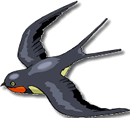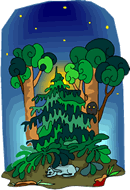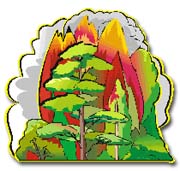Habitats |
Facts and Figures   |
|||
 A habitat is the environment in which an individual, population, community, or species lives. A habitat is the environment in which an individual, population, community, or species lives. Habitat destruction is the single most important danger to wildlife. Habitat loss is harmful, not only to a single kind of animal or plant, but to entire ecological communities. There are few parts of the world that have not been altered, damaged, or destroyed by the destruction of natural habitats. Speeding Up the Process
Modern technology speeds up the process of habitat destruction. Serious damage can be done in a tiny proportion of the time that it would have taken in the past. By the year 2032, more than 70% of the Earth's land surface is likely to be destroyed, fragmented, or disturbed by cities, roads, mines, and other infrastructures of human civilization. Fragmenting the Land
Habitat fragmentation is also a threat. This is the breaking up of large natural places into smaller fragments, or islands, of habitat. Some large animals, like mountain lions, moose, and brown bears, need large home ranges. When large stretches of natural habitat is broken up by human development, many animal populations decline. |
||||
Causes of Habitat Destruction |
||||
 Urban Development - As more and more people move to the cities, urban sprawl replaces natural habitats. The habitats that remain are fragmented and depleted. Urban Development - As more and more people move to the cities, urban sprawl replaces natural habitats. The habitats that remain are fragmented and depleted. Road Building - Agriculture, logging, mining, and the development of urban areas all lead to road building. Dirt roads used in forest or mining operations can cause erosion and landslides. Paved roads, on the other hand, cause run-off, so polluted water ends up contaminating nearby land and water. Roads cut through ecosystems causing fragmentation. Where there are roads, species are at risk from traffic and are more likely to be killed by legal or illegal hunting or trapping. Water development - Humans sometimes interfere with the natural flow of rivers and streams. We build dams, try to control floods, divert water for irrigation, and dredge waterways. These activities often result in an increase in water temperature and salinity, the removal of important nutrients and silt from the water, and changes in upstream and downstream habitats, including wetlands and marshes. Pollution - Ecosystems can be damaged by the introduction of sulphur compounds, ozone, pesticides, and heavy metals. Airborne pollutants, such as acid rain, often impact on natural communities far away from the source of the pollution. Humans can poison water with toxic materials (including mercury, lead, PCBs and DDT) that can interfere with the immune, nervous, and reproductive systems of many species. Many endangered and threatened bird species, such as the peregrine falcon, the bald eagle, and the osprey, suffered reproductive problems linked to the use of the pesticide DDT. |
Fire suppression - Fire is essential to the health of many ecosystems. Fire helps to quickly turn organic matter into mineral components that can help plants grow! Many plant species, such as Lodgepole pine, need fire to trigger the release of their seeds. Fire can also help to clear out older growth from a habitat and give other plants a chance to grow and thrive. The prevention of all forest fires can actually lead to fires that burn for longer due to the accumulation of organic matter. The suppression of fire has caused the decline of many endangered ecosystems including grasslands, savannas, pine barrens, and open forests.  Forest fires - Fire causes severe damage to tropical forest ecosystems, which do not normally burn and are extremely prone to severe fire damage. Tropical forest destruction, through fire, may affect our weather systems in new and unpredictable directions. Forest fires - Fire causes severe damage to tropical forest ecosystems, which do not normally burn and are extremely prone to severe fire damage. Tropical forest destruction, through fire, may affect our weather systems in new and unpredictable directions. Recreation - Outdoor recreation can also harm wildlife and habitats. Off-road vehicles can provide access to remote wilderness areas and can lead to the disturbance of natural habitats. Boats can bring invasive species, like the zebra mussel and milfoil, into waterways. |
|||
